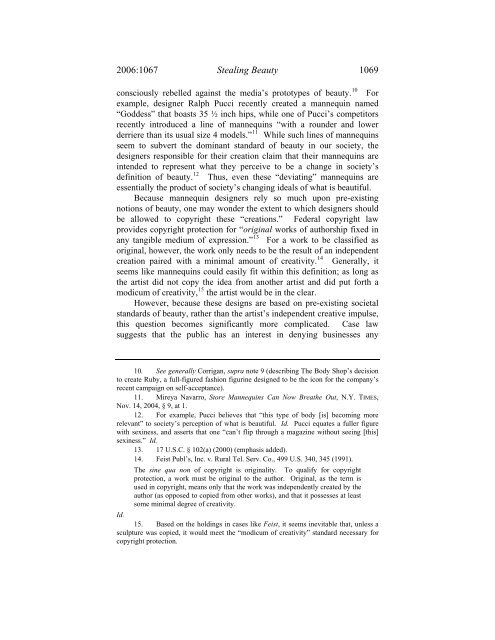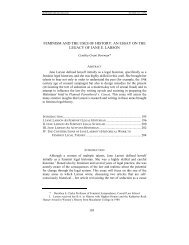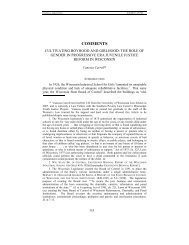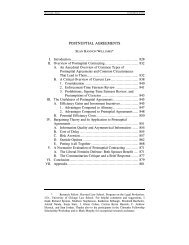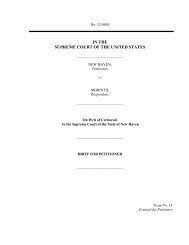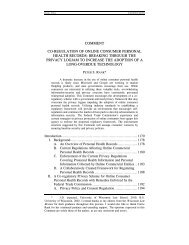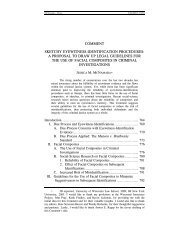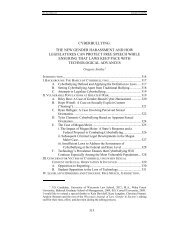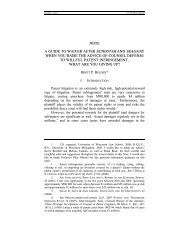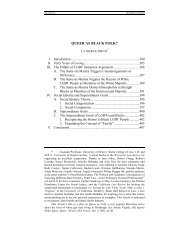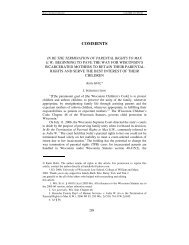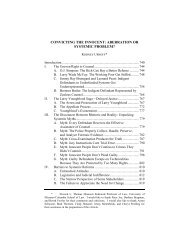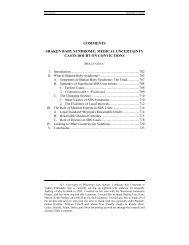Stealing Beauty: Pivot Point International v ... - UW Law School
Stealing Beauty: Pivot Point International v ... - UW Law School
Stealing Beauty: Pivot Point International v ... - UW Law School
Create successful ePaper yourself
Turn your PDF publications into a flip-book with our unique Google optimized e-Paper software.
2006:1067 <strong>Stealing</strong> <strong>Beauty</strong> 1069<br />
consciously rebelled against the media’s prototypes of beauty. 10 For<br />
example, designer Ralph Pucci recently created a mannequin named<br />
“Goddess” that boasts 35 ½ inch hips, while one of Pucci’s competitors<br />
recently introduced a line of mannequins “with a rounder and lower<br />
derriere than its usual size 4 models.” 11 While such lines of mannequins<br />
seem to subvert the dominant standard of beauty in our society, the<br />
designers responsible for their creation claim that their mannequins are<br />
intended to represent what they perceive to be a change in society’s<br />
definition of beauty. 12 Thus, even these “deviating” mannequins are<br />
essentially the product of society’s changing ideals of what is beautiful.<br />
Because mannequin designers rely so much upon pre-existing<br />
notions of beauty, one may wonder the extent to which designers should<br />
be allowed to copyright these “creations.” Federal copyright law<br />
provides copyright protection for “original works of authorship fixed in<br />
any tangible medium of expression.” 13 For a work to be classified as<br />
original, however, the work only needs to be the result of an independent<br />
creation paired with a minimal amount of creativity. 14 Generally, it<br />
seems like mannequins could easily fit within this definition; as long as<br />
the artist did not copy the idea from another artist and did put forth a<br />
modicum of creativity, 15 the artist would be in the clear.<br />
However, because these designs are based on pre-existing societal<br />
standards of beauty, rather than the artist’s independent creative impulse,<br />
this question becomes significantly more complicated. Case law<br />
suggests that the public has an interest in denying businesses any<br />
10. See generally Corrigan, supra note 9 (describing The Body Shop’s decision<br />
to create Ruby, a full-figured fashion figurine designed to be the icon for the company’s<br />
recent campaign on self-acceptance).<br />
11. Mireya Navarro, Store Mannequins Can Now Breathe Out, N.Y. TIMES,<br />
Nov. 14, 2004, § 9, at 1.<br />
12. For example, Pucci believes that “this type of body [is] becoming more<br />
relevant” to society’s perception of what is beautiful. Id. Pucci equates a fuller figure<br />
with sexiness, and asserts that one “can’t flip through a magazine without seeing [this]<br />
sexiness.” Id.<br />
13. 17 U.S.C. § 102(a) (2000) (emphasis added).<br />
14. Feist Publ’s, Inc. v. Rural Tel. Serv. Co., 499 U.S. 340, 345 (1991).<br />
The sine qua non of copyright is originality. To qualify for copyright<br />
protection, a work must be original to the author. Original, as the term is<br />
used in copyright, means only that the work was independently created by the<br />
author (as opposed to copied from other works), and that it possesses at least<br />
some minimal degree of creativity.<br />
Id.<br />
15. Based on the holdings in cases like Feist, it seems inevitable that, unless a<br />
sculpture was copied, it would meet the “modicum of creativity” standard necessary for<br />
copyright protection.


